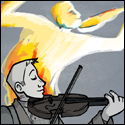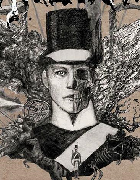|
KYOON GRIFFEY JR posted:I'd make a strong argument that many societies in antiquity were genocidal! That makes genocide unactionable.
|
|
|
|

|
| # ? May 23, 2024 22:30 |
|
13th KRRC War Diary, 1st Mar 1918 posted:The Battalion is now in support, the Rifle Brigade being in the line and the Royal Fusiliers in reserve.
|
|
|
|
I'm going to massively enrich the thread by saying I've been to the Hooge Crater and it's loving gigantic.
|
|
|
|
Slim Jim Pickens posted:That makes genocide unactionable. I don't think we should model our modern morality on the likes of the Romans. Auferre, trucidare, rapere, falsis nominibus imperium; atque, ubi solitudinem faciunt, pacem appellant.
|
|
|
|
Hooge Crater itself is located in the grounds of the old chateau. First fought over in the dog days of First Ypres, the front moved a mile or so up the Menin Road and then returned during Second Ypres, after which the line congealed nastily around Hooge, only a few hundred yards ahead of the literal last-ditch GHQ Line protecting Ypres. It then got even worse after a number of local attacks from both sides, which among many other things saw the first use of Flammenwerfers against the BEF. (The crater itself was blown in July 1915, an early demonstration of the skills of a specialist tunnelling company which used "clay-kicking" miners.) The far right edge of this 1917 map should give you some idea of the rampant bullshittery at work in the area. Hooge Crater itself I believe is the hatched red circle just above the G in "Hooge". http://maps.nls.uk/view/101464903 There's plenty of interest in squares I6, I12, and I18. Most notably, evidence of someone having obeyed orders with gleeful malignancy; this is an area where someone senior has tried to clamp down on undisciplined trench naming by whoever happened to be the first to occupy a position and insisted that all trench names here begin with the letters ID and IG; and someone slightly more junior has begun responding with "Ignorance Trench" and "Ignorance Reserve", followed it up with a series of "Idle" musings, and then really gone for the jugular with "Idiot Avenue" and about seven variants. It got much worse than this, mind you. For several months in 1915, there was a small NW-facing hook in the line in square I12 which ran approximately from the corner of the salient to the W in Idea Row; it wasn't uncommon for BEF men in the hook to be positioned facing west and hear bullets going over their head which had been fired by their friends behind them in Railway Wood at the Germans who were stuck in the crisis of Identity. (Now remember that this is Flanders, so it all floods at the drop of a hat and all the trenches collapse and you can't dig too far down without going into the water table.) Fortunately, by the time of this war diary, the Third Battle of Ypres has happened and the front has moved a few miles east towards Roulers. This map is the one that joins on directly to the east of the last one, but from December 1917, after the Third Battle of Ypres. http://maps.nls.uk/view/101464909 That's where the blokes are right now. Passchendale village, or what's left of it, is dead centre at the top. The railway you can see leaving the previous map enters this map in J1; the Menin Road enters in J13. A Company and C Company are in square J14. A Coy is in the south-eastern corner of J14, by Inverness Copse. C Coy is in the north-western corner, on the west edge of Glencorse Wood. B Company and D Company are in square J9. D is at Polygonveld and B is I think just to the south, but nearby. In this 1:10000 map from before Third Ypres you can see a major German position, with wire entanglements in front, running south through J9 to guard Polygon Wood (there's another one in J14), and I reckon the old German trench has been taken over and switched round, while being left unmarked on the post-battle map. The tunnels around here would have been built by the previous occupants, as we can also tell by their having electric lighting. Their job is, at the moment, to reinforce and be a first backstop for the bit of front-line running between NW J22, in front of Gheluvelt, location of a famous stand by the 1st Worcestershires in 1914 that saved the BEF from being thrown into the sea, and NW J17 at Juniper Cottages, which seems to have been captured by a local attack after the December 1917 map was drawn. The boundaries are both marked by small streams, the Polygonebeek in the north and the Scherriabeek in the south. Very soon they'll go all the way up and occupy the trenches there for a few days. Trin Tragula fucked around with this message at 14:14 on Mar 8, 2018 |
|
|
|
https://i.imgur.com/ZcKsTEn.gifv
|
|
|
|
Go on.
|
|
|
|
|
SeanBeansShako posted:Go on. "Lead ball from a flintlock musket flattens against a 17th century cuirass reproduction"
|
|
|
|
I need to take a shower, be right back.
|
|
|
|
|
Miranda Carter, George, Nicholas and Wilhelm: Three Royal Cousins and the Road to World War I posted:“In an effort to distract him, the kaiser’s entourage decided to put on an entertainment, the kind that amused him: a ballet spectacular performed by the middle-aged members of his various cabinets. The climax was a performance by Field Marshal Count Dietrich von Hülsen-Haeseler, the hefty, fifty-six-year-old chief of Wilhelm’s military cabinet. Described in some sources as wearing a pink tutu (”not for the first time,” Zedlitz-Trützschler wrote), in others a pink ball gown – what was undisputed was that he was in drag – with a large feather in his hair, he performed a series of energetic pirouettes, jumps and capers, flirtatiously blew kisses to his audience, stumbled off the stage and suffered a massive heart attack that killed him instantly. It was reported that by the time the doctors arrived, rigor mortis was so far advanced that it was extremely difficult to get Hülsen out of his tutu and into his military uniform. The story made Wilhelm look even more irresponsible and odd; in the French, Italian, and British papers there were gleeful screeds about German moral degeneracy.” for the love of god tell me this actually happened.
|
|
|
|
Mycroft Holmes posted:for the love of god tell me this actually happened. wilhelm and his close friends enjoyed drag shows, and regularly participated in them.
|
|
|
|
Mycroft Holmes posted:for the love of god tell me this actually happened. The Aristocrats!
|
|
|
|
Trin Tragula posted:http://maps.nls.uk/view/101464903
|
|
|
|
I had to drink about four cups of coffee to get my hangover down to a manageable level: When it comes to war, soldiers, civilians and atrocities, there are a whole bunch of different factors at work. For instance, when you look at something like the War of the Roses which lasted for years, there's an extremely low count for civilian deaths because of how the nature of the war played out. Someone mentioned the chevauchees, but that was a completely different kind of war between two rival crowns. Also not something that was widely accepted at the time as morally acceptable. Before nationalism, even long wars tend to have an absence of battles in general. Armies are on the average fairly small (you get periods where this isn't true, like the 1630's in the 30YW), they have a relatively small footprint and most importantly, the labor of war is not something that the average peasant, burgher or yeoman has a part in. Wars are a duty of the crown or the state or the nobility, and that is what they do. Nationalism changes this, and I think that what with nationalism and all, there becomes an idea that someone from the enemy nation is automatically at least partially your enemy, and not just an average schlub trying to live his life. Caesar in Gaul killed a huge amount of people, and enslaved even more, but I don't think there's any sort of indication that it wasn't either mostly for profit or incidental, unlike the Luftwaffe trying to terror bomb London into submission. The Hague and Geneva conventions are maybe an attempt to curb the excesses inherit in the idea that wars are between nations, but at the same time, the ratio of soldiers dying as opposed to civilians dying in war changes radically after WW1. In conflicts since then, civilian casualties have always been greater than military casualties. So I guess end nationalism and hang all nobles.
|
|
|
|
Kemper Boyd posted:The Hague and Geneva conventions are maybe an attempt to curb the excesses inherit in the idea that wars are between nations, but at the same time, the ratio of soldiers dying as opposed to civilians dying in war changes radically after WW1. In conflicts since then, civilian casualties have always been greater than military casualties. I'm pretty sure that civilian casualties are higher than military in almost every war barring a few exceptions and although pitched battles might be rarer in ancient wars there's a significant amount of raiding that's not mentioned because it's assumed to happen.
|
|
|
|
HEY GUNS posted:this was 100 percent real Do you have any sources? I literally never heard of this, and I've read a lot about Wilhelm being weird
|
|
|
|
Ithle01 posted:I'm pretty sure that civilian casualties are higher than military in almost every war barring a few exceptions and although pitched battles might be rarer in ancient wars there's a significant amount of raiding that's not mentioned because it's assumed to happen. An army racks up a significant civilian death just by moving thorough the landscape, even without any violence whatsoever. It's hard for us to get our head round what a concentration of hundreds of thousands of people actually meant before there were logistics to support them. In a time before long food supply chains, an army is stripping away food from the surrounding countryside, with no quick way to replenish it. Soldiers are carrying disease, making GBS threads into the water supply in huge volumes. If the army stops for any length of time, outbreaks of typhus and dysentery are almost inevitable. Even if the soldiers are relatively friendly and well behaved, civilians are going need to stay behind closed doors to avoid falling victim to a bit of warm-up sacking. At certain times of year that can keep them away from the field at crucial moments, meaning losing the entire year's food crop.
|
|
|
|
Victor Hutchinson's POW Diary Friday 2nd March Bitterly cold and depressing. Many rumours circulating throughout the camp, but later all officially denied by the G/C. Later we had another bread ration cut of 15gms. Further outlook on food front is very depressing.
|
|
|
|
Worth pointing out that in WWII, civilian casualties are higher than military casualties only because of the efforts of Nazi Germany and Japan, especially on the Eastern Front and in China. If you are excusing Caesar in Gaul as 'doing atrocities for profit', then that's pretty much the same rationale as Lebensraum or Japan's neo-colonial project in China. Terror bombing, while killing lots of people, was not what made the war so lethal. The difference seems to me to be more down to how you count and classify civilian casualties of war. For example the civilian casualties of colonialism are grotesquely high, but they are typically disregarded. Even when famines and so on are considered, they are not included with the original war. Compare say, the Iraq war, where casualties during the occupation are included in overall casualty figures, where the possibility of ending that war at all seems vaguely defined. Fangz fucked around with this message at 11:44 on Mar 2, 2018 |
|
|
|
Libluini posted:Do you have any sources? I literally never heard of this, and I've read a lot about Wilhelm being weird I mean you can just google the dude - https://en.wikipedia.org/wiki/Dietrich_von_H%FClsen-Haeseler https://books.google.co.uk/books?id...aeseler&f=false I'd heard this before too, so it's not just Hey Guns. 
|
|
|
|
Mr Enderby posted:It's hard for us to get our head round what a concentration of hundreds of thousands of people actually meant before there were logistics to support them. This wasn't a common occurrance for most of recorded European history, though. Armies stayed relatively small after the collapse of the Western Roman Empire, and in the 17th century you see armies doing that for a bit but then they shrink again because of logistics and finances.
|
|
|
|
Denmark is having a light blizzer, can we talk about cold in warfare? Give me your Simo Häyhas and your mountaintop bunker rushes!Gort posted:Swagman Medieval Iceland had bunch of different cool sundowner hustles. A common hobo technique was cruising around the country and visitng every house on the way, saying you were on your way to a meeting, don't be an rear end in a top hat, you can give me a couple of sandwiches and a bed with your daughter
|
|
|
|
Kemper Boyd posted:This wasn't a common occurrance for most of recorded European history, though. Armies stayed relatively small after the collapse of the Western Roman Empire, and in the 17th century you see armies doing that for a bit but then they shrink again because of logistics and finances. Ok, I might have overstated the numbers a touch, but I deliberately wrote "people" rather than soldiers. However large the stated strength of an army, the actual number of mouths to feed was considerably higher.
|
|
|
|
Gort posted:I'm going to massively enrich the thread by saying I've been to the Hooge Crater and it's loving gigantic. I've only been past Hooge Crater (though planning to visit in October), but it's full of water and pretty much a large pond/small lake, isn't it? Lochnagar Crater, on the other hand...
|
|
|
|
Tias posted:Denmark is having a light blizzer, can we talk about cold in warfare? Give me your Simo Häyhas and your mountaintop bunker rushes! One of the most terrifying military history books I've ever read was about the Austrian-Russian front in the Carpathian Mountains during WW1. All the horrors of WW1, now high above the clouds in arctic conditions and featuring one of the most poorly lead and equipped armies in the conflict. Blood on the Snow posted:Readers of this investigation will note the frequent depiction of Habsburg troops as utterly exhausted and increasingly apathetic. At the risk of sounding repetitive, the mental and physical condition of Habsburg troops is critical to understanding the Carpathian Winter War. The exhaustion experienced in combat under winter conditions is incomprehensible to those who have not suffered under such circumstances. Reading the daily log-books of Habsburg units participating in the Carpathian Winter War, one would be hard-pressed to find an entry that did not include the words ganz eschopft ("utterly exhausted"). The men's physical and mental exhaustion was exacerbated by hunger. Food supplies often did not reach the front, and those that did were often frozen solid. The men began to hallucinate about food, driving them to near insanity. In the winter of 1915, not only did Habsburg Supreme Command decide to deploy massive armies into a region unfit for a major combat operation, but also, it did so with no provision for the most basic of necessities - food, clothing, and shelter.
|
|
|
|
'Hey where the gently caress is corporal Herschel?' 'Wolves got him....'
|
|
|
|
|
Mycroft Holmes posted:for the love of god tell me this actually happened. https://www.youtube.com/watch?v=veH3KI3Ycdw
|
|
|
|
So who here ever wondered what British soldiers and officers of the late 19th century wore aside from the black cork home service helmets? aside from me. Presenting a rather fascinating section of this website dedicated to late 19th century British forage caps.
|
|
|
|
|
Kemper Boyd posted:Caesar in Gaul killed a huge amount of people, and enslaved even more, but I don't think there's any sort of indication that it wasn't either mostly for profit or incidental, unlike the Luftwaffe trying to terror bomb London into submission. It's weird when slaughtering people in the name of profit is a positive thing. I mean, I get what you mean, but it's not like the Romans in general were strangers to the idea of "we hate these people beyond mere warfare and want them to die." They did their own exterminations in Carthage, Israel, and there was at least one emperor who tried exterminating a specific German tribe, the name escapes me. The differences are mostly technological. The weird thing about bombing is that it starts the killing before taking the city with troops is an option. The holocaust involved a level of organization in killing that wouldn't have really been available to the Romans. And most importantly, modern media removes a lot of the distance and obfuscation from the atrocities and the societies that they are supposedly done in the name of. It's hard to really get your head around how devastating some ancient campaigns were. It's also possible that modern morals are more developed and stringent than historical ones, but I don't know much about that. History of philosophy is weird to track.
|
|
|
|
Mr Enderby posted:An army racks up a significant civilian death just by moving thorough the landscape, even without any violence whatsoever. It's hard for us to get our head round what a concentration of hundreds of thousands of people actually meant before there were logistics to support them. In a time before long food supply chains, an army is stripping away food from the surrounding countryside, with no quick way to replenish it. Soldiers are carrying disease, making GBS threads into the water supply in huge volumes. If the army stops for any length of time, outbreaks of typhus and dysentery are almost inevitable. Even if the soldiers are relatively friendly and well behaved, civilians are going need to stay behind closed doors to avoid falling victim to a bit of warm-up sacking. At certain times of year that can keep them away from the field at crucial moments, meaning losing the entire year's food crop. In this case I was thinking specifically of something akin to the Peloponnesian wars. Few direct pitched battles, but a near constant state of violence pervasive through out a region over a long time (and a recurring plague). Even though the battles might not result in piles of corpses the overall effect of disease, violence, and civil disorder was to significantly reduce the population of Greece. I'm also thinking of an account of a city sacking during the initial Manchu conquest of China written by a Chinese author who was living in the city at the time. It's not great.
|
|
|
|
Cythereal posted:One of the most terrifying military history books I've ever read was about the Austrian-Russian front in the Carpathian Mountains during WW1. All the horrors of WW1, now high above the clouds in arctic conditions and featuring one of the most poorly lead and equipped armies in the conflict. HEY GUNS fucked around with this message at 20:44 on Mar 2, 2018 |
|
|
|
Kemper Boyd posted:Caesar in Gaul killed a huge amount of people, and enslaved even more, but I don't think there's any sort of indication that it wasn't either mostly for profit or incidental, unlike the Luftwaffe trying to terror bomb London into submission. One time Caesar cut the hands off every adult male in a Gaullic city he sacked. It would have been more profitable to sell them as slaves. That's not exactly what the Luftwaffe did but I don't think it's that radically different.
|
|
|
|
That's just Belgium.
|
|
|
|
Clarence posted:I've only been past Hooge Crater (though planning to visit in October), but it's full of water and pretty much a large pond/small lake, isn't it? Hooge Crater had a bunch of scrubby bushes and shrubs in it when I saw it, but that was decades ago.
|
|
|
|
I can't be only person to say ouch out loud. Like id be doubled over with broken ribs and air knocked out of me right?
|
|
|
|
Milo and POTUS posted:I can't be only person to say ouch out loud. Like id be doubled over with broken ribs and air knocked out of me right? modern bulletproof vests are also not fun to get shot in
|
|
|
|
I should have used that map.  13th KRRC War Diary, 2nd Mar 1918 posted:Early in the morning Working Parties were organized and commenced cleaning up and repairing the damage which was done last night. The two horses were buried in a neighbouring shell-hole, and rations and fuel were separated. This took the greater part of the morning. Several men were sent down to transport who were proceeding on leave on the 4th in order that they may bath and clean themselves.
|
|
|
|
There is no protective gear that makes it comfortable getting into an accident. Wearing a helmet and tripping on your bike hurts like gently caress but your brain won't be smashed as much. Falling on a harness feels terrible, but not quite as terrible as without it.
|
|
|
|
HEY GUNS posted:but you would not be shot Eh, sometimes I kinda wish I got shot on some crappy field somewhere in the 16th century
|
|
|
|

|
| # ? May 23, 2024 22:30 |
|
You want a sphere of lead to slam into your gut and shred your vital organs bringing your clothing, skin and whatever dirt was around you and the owners mouth deep into a bloody new cavity? That is a very ah, intense fantasy my friend.
|
|
|
|



























